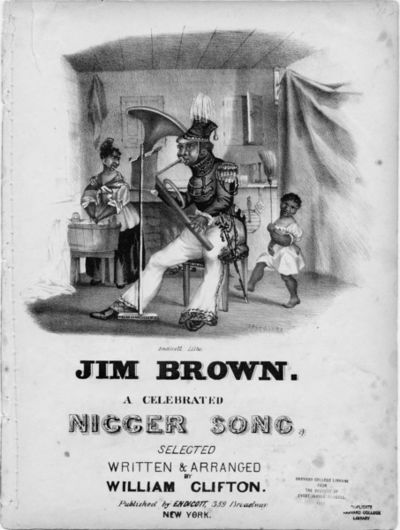Annotation:Jim Brown: Difference between revisions
No edit summary |
No edit summary |
||
| (2 intermediate revisions by 2 users not shown) | |||
| Line 1: | Line 1: | ||
---------- | |||
---- | {{TuneAnnotation | ||
|f_tune_annotation_title=https://tunearch.org/wiki/Annotation:Jim_Brown > | |||
'''JIM BROWN.''' American, Minstrel Air (2/4 time). G Major. Standard tuning (fiddle). AB. | |f_annotation='''JIM BROWN.''' American, Minstrel Air (2/4 time). G Major. Standard tuning (fiddle). AB. | ||
[[File:jimbrown.jpg| | [[File:jimbrown.jpg|400px|thumb|left|Jim Brown songsheet, c. 1836]] | ||
The figure depicted in the cover the to the sheet music to the left is dressed in a band costume. It has been suggested that the cover caricatures African-American bandleader Francis Johnson, who led a very successful | The figure depicted in the cover the to the sheet music to the left is dressed in a band costume. It has been suggested that the cover caricatures African-American bandleader, composer, violinist and keyed-bugle player Francis Johnson (1792-1844), who led a very successful band of African-American musicians in Philadelphia, and who had an international reputation for his music (see [[Annotation:Philadelphia Fireman's Cotillion (The)]]). The cover also depicts the man as a variant of the black 'dandy' (albeit in uniform rather than evening-dress), a stereotypic figure in the minstrel era that started early with such songs as "[[Zip Coon]]" and "[[Long Tail Blue]]." | ||
|f_source_for_notated_version= | |||
|f_printed_sources=Gumbo Chaff ('''The Complete Preceptor for the Banjo'''), 1851; p. 14. Elias Howe ('''Second Part of the Musician’s Companion'''), 1843; p. 57. | |||
|f_recorded_sources= | |||
|f_see_also_listing= | |||
}} | |||
------------- | |||
'' | |||
---- | |||
Latest revision as of 18:40, 31 January 2021
X:1 T:Jim Brown M:2/4 L:1/8 R:Minstrel tune B:Elias Howe – Second Part of the Musician’s Companion (1843, p. 57) Z:AK/Fiddler’s Companion K:G G/A/|B/G/G/G/ B/G/G/G/|dA/F/ D>D|D/E/F/G/ A/B/c/A/|B/G/A/F/ G:| |:D|G/B/d/f/ gg/g/|g/d/B/G/ D>D|D/E/F/G/ A/B/c/A/|B/G/A/F/ G:|
JIM BROWN. American, Minstrel Air (2/4 time). G Major. Standard tuning (fiddle). AB.

The figure depicted in the cover the to the sheet music to the left is dressed in a band costume. It has been suggested that the cover caricatures African-American bandleader, composer, violinist and keyed-bugle player Francis Johnson (1792-1844), who led a very successful band of African-American musicians in Philadelphia, and who had an international reputation for his music (see Annotation:Philadelphia Fireman's Cotillion (The)). The cover also depicts the man as a variant of the black 'dandy' (albeit in uniform rather than evening-dress), a stereotypic figure in the minstrel era that started early with such songs as "Zip Coon" and "Long Tail Blue."

